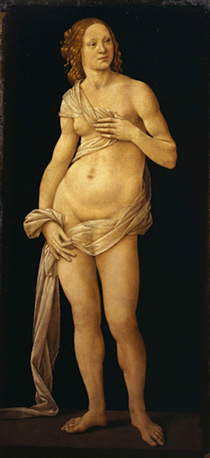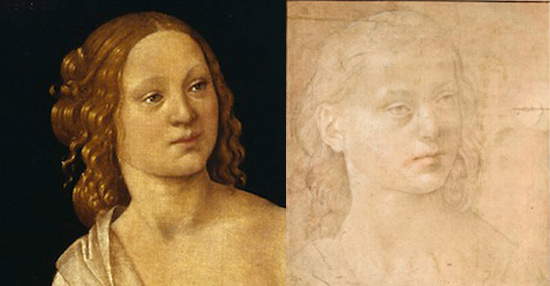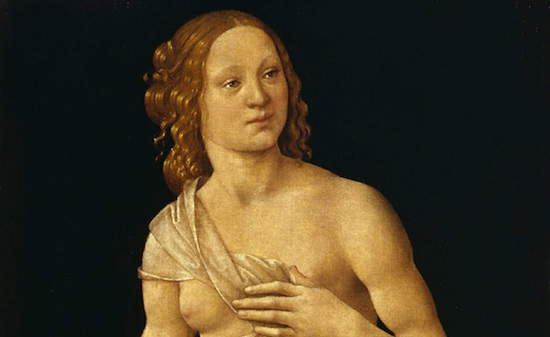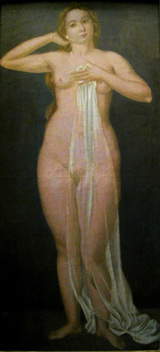 |
| Lorenzo di Credi, Venus (c. 1490-1494; oil on canvas, 151 x 69 cm; Florence, Uffizi) |
Art historian Gigetta Dalli Regoli, author of what is probably still today the only monograph of any depth on Lorenzo di Credi, published in 1966, suggested in that same volume that the only trait that would liken Lorenzo’s Venus to Sandro’s would be nothing more than the common archetype, the work from which both were inspired: a classical statue, of the Venus pudica type (i.e., the type in which the goddess covers her breasts with one hand and her pubis with the other), which was probably found in Florence as early as the fifteenth century, although it was not the celebrated Venus of the Medici, the one now preserved in the Uffizi Tribune, which arrived on the banks of the Arno only in the late sixteenth century. A common archetype, but different ways through which to concretize inspiration. Even the face of Lorenzo’s Venus appears to us so far removed from that of Botticelli’s Venus: not very idealized, but lush and natural, in keeping with the Verrocchiesque dictates on which Lorenzo was formed. More human, if you will. Lorenzo di Credi’s intentions are also confirmed for us by what appears to be a preparatory drawing traced on a sheet now in theAlbertina in Vienna: the same pose, the same gaze full of life have led scholars to associate the drawing with Lorenzo’s Venus.
 |
| The face of Lorenzo di Credi’s Venus compared with the drawing preserved in the Albertina in Vienna (inventory no.: 4870) |
 |
| Lorenzo di Credi, Venus, detail |
It was said in the opening that a work like Lorenzo’s could only be forgotten: perhaps it was its distance from Botticelli’s instances that decreed its failure. Sandro Botticelli was, after all, the artist of reference: he was more experienced and better placed, even though Lorenzo, at the time of the painting’s completion, could boast of having inherited the workshop of the late Verrocchio, his master, for some years. And the running of the workshop engaged him incessantly. As a result, all his contemporary commentators, but also those who came later, praised Botticelli’s Venus and forgot about his own. Which, moreover, was probably made for a private individual: the wealthy citizens of Medici Florence, Lorenzo’s favorite clients, for whom he worked most often, liked to adorn their homes with paintings with mythological themes. And the fact that Lorenzo’s unknown patron hid the Venus from the view of others certainly did not contribute to the work’s fame. On the other hand, we can, without any doubt, consider the contention that scholar Enrico Ridolfi, one of the first to study Lorenzo’s Venus, hypothesized in 1893 to justify the painting to be a figment of our imagination: he thought, in fact, that Lorenzo the Magnificent himself had called a competition between Lorenzo and Botticelli for the Venus to be destined for the Villa di Castello and that, needless to say, Botticelli had won the favor of the de facto lord of Florence. Ridolfi adduced as evidence the fact that a Botticelli Venus standing out against a dark background, like Lorenzo’s, was preserved (and still is, in the Staatliche Museen) in Berlin. Also belonging to the same type is the Venus in the Gualino collection, variously attributed to Botticelli or his workshop, and now in the Galleria Sabauda in Turin. Ridolfi thought these were models made in preparation for a more challenging painting: but they were, instead, often derivative works intended for private collecting. Moreover, taking Ridolfi’s invented story at face value, it would be necessary to anticipate the realization of Lorenzo’s Venus by about ten years: too early for such a mature painting, which could hardly have been executed before 1490. There are also those who hypothesize, on the basis of comparison with other works, a more restrictive dating, around 1493, and in any case no later than 1494, the year in which the Medici were driven out of Florence and the regime of Girolamo Savonarola was established in the city.
 |
| Comparison of Venuses: from left, that of Lorenzo di Credi; Sandro Botticelli (c. 1482-1484; Florence, Uffizi); attributed to Sandro Botticelli (c. 1482-1486; Turin, Galleria Sabauda); school of Sandro Botticelli (c. 1490; Berlin, Staatliche Museen) |
 |
| Maurice Denis, Nu à la manière de Lorenzo di Credi (1898; Saint-Germain-en-Laye, Musée Maurice Denis) |
Today, at the Uffizi, hordes of visitors queue up to enter the room where Botticelli’s Venus is kept, while Lorenzo’s goes almost unnoticed: it is the power of idols, we might think. Nevertheless, Lorenzo’s Venus has also exerted and exerts a certain fascination on many who admire it. We need only think of the homage that a great artist of the last century, Maurice Denis, dedicated to her: his Nu à la manière de Lorenzo di Credi, made in 1898 and now kept at the Musée Maurice Denis in Saint-Germain-en-Laye, was born precisely out of a reflection on Venus. And, perhaps less poetically but certainly just as concretely, the image of Lorenzo’s work has long since begun to circulate on the Web, or in the social profiles of art lovers. The fame of this painting will probably never reach that achieved by other works that are now part of the collective imagination. But it certainly cannot be said that this forgotten Venus has not taken, for at least a hundred years, a lot of good revenge.... !
Warning: the translation into English of the original Italian article was created using automatic tools. We undertake to review all articles, but we do not guarantee the total absence of inaccuracies in the translation due to the program. You can find the original by clicking on the ITA button. If you find any mistake,please contact us.